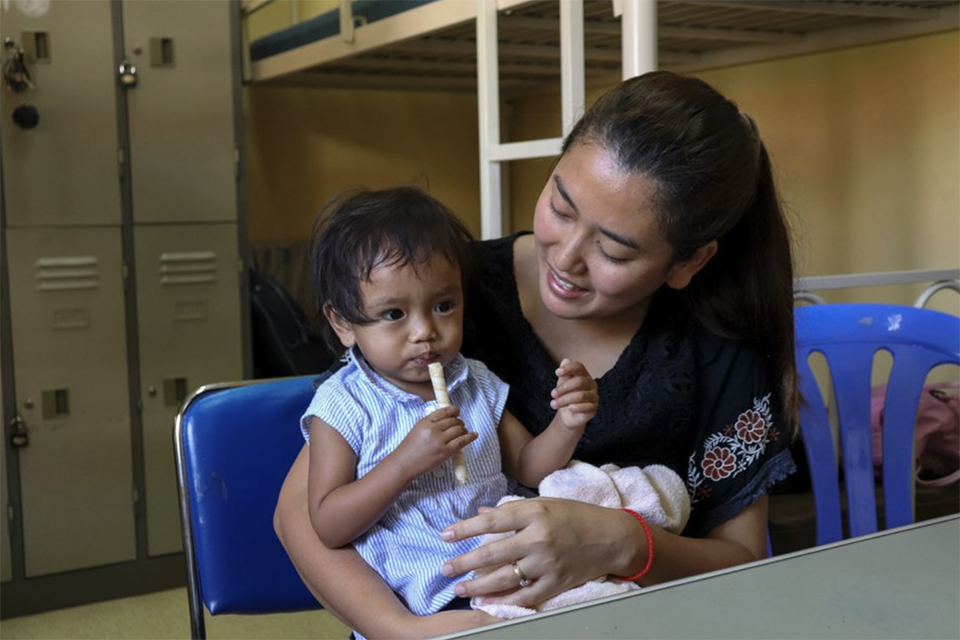The Big Fish Series delves into full-fish utilization and the logistical and cultural challenges in front of increasing whole-fish consumption

With a growing global population and finite resources with which to feed billions of people, food utilization and food waste solutions are topics ripe for examination.
Stirling University’s The Big Fish Series of webinars – produced in line with the EU Horizon 2020 Fund’s GAIN (Green Aquaculture Intensification) project – set out to do just that last week. In a discussion led by Professor David Little, the group provided an overview of global whole-fish consumption and pondered whether it can be further encouraged through education, innovation and policy to curb seafood waste.
The question “why is seafood wasted?” has many answers, the panelists concluded, but culture and economics are the primary factors in whole-fish consumption, said Nireka Weeratunga, research fellow at the International Centre of Ethnic Studies in Columbo, Sri Lanka.
“It’s not only a characteristic of poor countries,” she said. “Norwegians consume cod cheeks and tongues. This is dependent mainly on cultural values. Eating the blander parts of the fish – the fillets – is part of lifestyle changes that prioritize convenience and hygiene.”
Lyndon Paul, managing director and founder of Danish Care Foods Ltd. in Cambodia, noted that whole-fish consumption in Cambodia declines as people climb income brackets.
“Poorer people in Cambodia might be consuming whole fish a lot,” he said. “Cultural status is important here. When you go up, people prefer bigger fishes and without bones or skin.”
Is processing part of the problem?
The main reasons why whole-fish consumption isn’t more widely practiced can be traced to the products themselves, and consumer preferences for them, the panelists agreed.
Most important to note is that fish products are quicker to spoil than most foods, so saving the parts with the most economic value – the fillets – and discarding the frames and skins not only extends shelf life of the fillets but reduces weight of seafood export shipments, a major environmental factor when it comes to shipping costs and carbon footprints.
In rural areas where seafood processing and cold-chain storage options may be limited or non-existent, whole-fish consumption is indeed far more common, as is consumption of smaller, migratory fishes, a range of small species commonly referred to as “trash fish.” This is a bit of a double-edged sword, according to Joao G. Ferreira, chief scientific officer for Longline Environment, Ltd.
“Eating the whole fish is great, but in certain parts of the world, that means eating rather small fish,” said Ferreira. “That can be a liability as it can affect recruitment.”
Ferreira, who is from Portugal, said that in his home country “everything is fair game” when it comes to fish and that there “it’s widely accepted that the best parts of the fish are the heads.”
Panelist Mike Berthet – a UK restaurant operator and business development representative for the Global Seafood Alliance – has worked in seafood for decades. He noted that seafood processors have a growing number of options to utilize food waste and that salmon companies have long sent discarded fish heads to impoverished countries. Processors are moving toward full utilization, sending trimmings for fishmeal and fish oil. Berthet said processors are getting better at using the entire animal, except for the blood, which can be expensive to valorize. Recirculating aquaculture systems (RAS) are taking it a step further by turning fish waste into fuels and fertilizers.
Berthet also alluded to the upcoming skrei (cod) season in Norway, in which children are traditionally involved in processing the fish and removing the tongues, which are considered a delicacy.
Jimmy Young, a Stirling professor-emeritus specializing in consumption, markets and cultures, said restaurants are exceptionally proficient at using all parts of the fish – think stews and soups – and in this way they can demonstrate how to cook fish and become more confident doing so at home. Planning and preparation are crucial for efficient whole-fish utilization, he added.
“It’s a delivered experience. Foodservice has a great role to play. Solutions are offered,” he said. “There’s a lot more to be done in terms of education.”

Safe at home?
Dave Love, senior scientist at Johns Hopkins University, said that every part of the seafood supply chain has some waste, but that processors and wholesalers are quite good at reducing wasteful practices. It’s the end points – primary producers and consumers – that account for the lion’s share of seafood waste, he said.
Research that Love and colleagues completed in 2015 determined that 40 to 47 percent of the total U.S. seafood supply was lost or wasted; that paper referenced a United Nations estimation from that 35 percent of all harvested seafood is later lost or wasted. Love told the Advocate that the figures from the UN’s 2012 report didn’t capture seafood waste in the United States, so his study was done in response and in fact used the same methods and many of the same data sets.
Wondering if a more focused effort with new approaches would yield a similar conclusion, Love is currently revisiting U.S. seafood waste habits and is collecting primary data for a study that will be released this year. Love and his research colleagues are expected to conclude that U.S. seafood waste is actually far lower.
“The amount is more like 20 percent, which is good news,” said Love, stressing that the findings are preliminary. The project involves researchers from Johns Hopkins, the University of Florida and Arizona State University.
Recapping his findings from a 2021 consumer waste study for the webinar, Love outlined four ways in which consumers typically waste seafood, or the “four Ps”:
- Proficiency: “There’s not a lot of confidence in the kitchen” when it comes to cooking fish, even less so with whole fish, Love said.
- Perceptions: “Do people see themselves as someone who wastes? Is waste important to them?” were key questions for survey participants, he concluded.
- Preparation: “Some are better at planning and preparing meals,” he said.
- Perishability: “Some associate fishy odors with food safety concerns. Education around that is critical,” he said.
Fresh or frozen?
Product-form preferences and local availability also play a large role in seafood waste. While some consumers in North America and Europe associate frozen fish with lower quality, many others don’t and in fact place a high value on the pre-portioned convenience and affordability of frozen products. Love’s 2021 study evaluated the potential of a “cook-from-frozen” approach to preventing seafood waste and found strong potential. What’s more, frozen fish is often much cheaper than fresh, as Love pointed to the average cost of frozen fish in the United States at $3 to $5 per pound, whereas fresh fish is often in the $8 to $10 per pound range.
Cooking fish from frozen might be a helpful strategy in North America or Europe, but in places like Sri Lanka, Weeratunga said, fresh fish is definitely preferred.
“Frozen is only accepted by more upper-income people who shop in supermarkets and so on,” she said. “After fresh fish, the next preferred thing is chicken or even dried fish, particularly in the interior regions of those countries. That’s how it’s been transported for centuries. Both kinds are still valued.”
Weeratunga, it’s worth noting, is an advisor to the group Dried Fish Matters, a nonprofit group mapping the social economy of dried fish in South and Southeast Asia for wellbeing and nutrition.
In Cambodia, smoked fish are very popular for similar reasons, said Paul, but fish is just generally the protein of choice in the country. Lower-income groups eat whole fish, he added, but so do those with higher incomes. During rainy season, he and his family still enjoy catching smaller fish like perch and snakehead near their home: “We fry them whole and eat them.”
This is dependent mainly on cultural values. Eating the blander parts of the fish – the fillets – is part of lifestyle changes that prioritize convenience and hygiene.
Whole fish fighting malnutrition
Nutrix – a snack that Paul’s company Danish Care Foods makes with fish proteins and introduced in 2019 in a collaboration with UNICEF, the French National Research Institute for Sustainable Development and Copenhagen University – is helping the Cambodian government meet its annual goal of treating at least 25,000 children for severe acute malnutrition.
Nutrix is a fish wafer, a therapeutic food made locally. Approximately 2.6 percent of Cambodian children suffer from acute malnutrition, while another 8 percent live with moderate to acute malnutrition. The fish wafers have been a huge success, Paul said, particularly for children 6 months and older, as few liked the milk-based product previously offered. They’re also 20 percent cheaper than imported alternatives.
“It’s processed whole fish, excluding the guts,” Paul said. “The species were all small – Siamese mud carp, silver mud carp, longfin carps, spotted barbs – also known as ‘trash fish.’ We grind them to a powder. It’s had a huge impact. People like the feel and the taste, and now they want other fish-based products. Fish is playing a part there.”
Follow the Advocate on Twitter @GSA_Advocate
Now that you've reached the end of the article ...
… please consider supporting GSA’s mission to advance responsible seafood practices through education, advocacy and third-party assurances. The Advocate aims to document the evolution of responsible seafood practices and share the expansive knowledge of our vast network of contributors.
By becoming a Global Seafood Alliance member, you’re ensuring that all of the pre-competitive work we do through member benefits, resources and events can continue. Individual membership costs just $50 a year.
Not a GSA member? Join us.
Author
-

James Wright
Editorial Manager
Global Seafood Alliance
Portsmouth, NH, USA
Related Posts

Responsibility
An African prison where fish will be farmed and lives saved
A nonprofit organization working to improve conditions in African prisons is hoping tilapia ponds, tended to by inmates, will aid in their nutrition. A small donation from the Global Aquaculture Alliance will go a long way.

Intelligence
Food is abundant, yet people are starving
While significant numbers of people are undernourished, an increasing number of people are overweight. The divide between recommendations and results is marked, so we must learn more about food production and change our behaviors.

Responsibility
Haiti’s hatchery of hope
Built on a dream of feeding some of the world’s poorest and most vulnerable people, a charity-built tilapia hatchery in Haiti now learns to stand on its own.

Responsibility
Can nutrition-sensitive aquaculture futureproof fish farming?
Research finds that nutrition-sensitive aquaculture can benefit public health through diverse, nutrient-rich seafood, and enabling equitable access to it.


